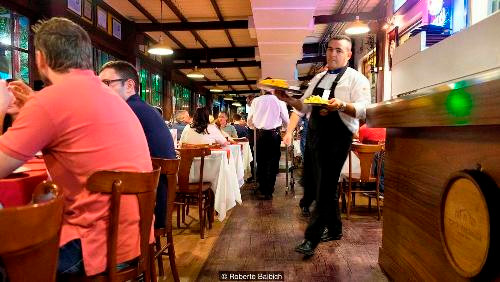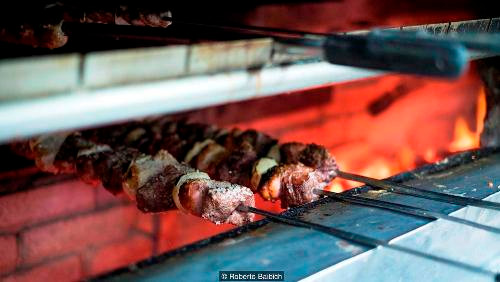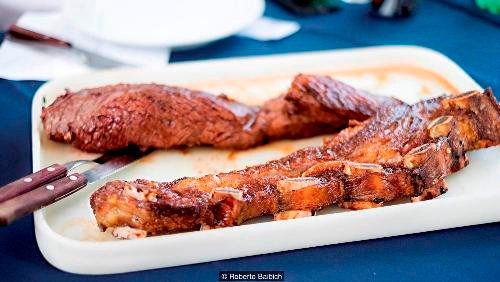Where people like to eat barbecue on Sundays
Coming to southern Brazil on Sundays, you will see locals going out for a barbecue, while the aroma of meat and charcoal smoke wafts through the streets.
Join BBC travel writer Leigh Crandall on a trip to Rio Grande do Sul, Brazil, where churrasco (the Portuguese word for grilled meat) is a cult-like affair.
Enjoy barbecue on Sundays
Walk down the streets of Porto Alegre on a Sunday and you’ll see charcoal smoke curling through the air, the smell of beef and pork on the grill wafting through the windows. Even the most modest apartments have kitchens equipped with churrasqueiras – brick-floored ovens filled with charcoal and topped with skewers of meat.
“In Rio Grande do Sul, eating meat is an integral part of our culture. And churrasco is as simple as salt and charcoal,” said Ilmar Tasca, manager of Barranco, a popular restaurant in Porto Alegre.
 |
Barranco Restaurant, a dining spot always crowded with diners in Brazil. Photo: Roberto Baibich |
What makes Rio Grande do Sul’s churrasco so famous is the quality of the beef. “It’s Black Angus, a breed of English cattle,” Tasca explains. “We’re very careful and only select young animals. We’re in constant contact with the ranchers to know how the cattle are doing.”
Standing in the kitchen of Barranco restaurant on a Sunday afternoon, the busiest time of the week, you will see everyone "dancing together". Waiters run in and out taking orders, skewers of meat are constantly being loaded into the oven. The amazing thing is that not a single mistake has been made in the kitchen.
Enjoying churrasco, as Tasca says, is “like the main activity of people on Sundays” (like the sheep going to pray in church). The tables at Barranco are designed for families and large groups, the space is always open, creating a comfortable feeling. When diners eat, the wall-mounted TV turns on football, people can eat and chat happily with relatives and friends.
 |
Churrasqueirain the kitchen of Barran restaurantco. Photo:Roberto Baibich |
Stories about grilled meat
The grilled meat at Churrascaria Santo Antonio is a local specialty. Leigh’s mother-in-law, who was born in southern Brazil, has been coming to the restaurant for decades. She said a friend of hers from Canada was visiting, a longtime vegetarian: “I brought my friend here, and the owner, knowing she didn’t eat meat, invited her into the kitchen. He showed her how the animals were raised, explained the care they took in sourcing the meat, and how they prepared it. She was so impressed that she decided to try a piece of grilled meat.”
It seems like everyone who has walked through the doors of the restaurant over the past 80 years has a story to tell. Leigh’s own story began at her first lunch there, when the waiter came by with a piece of meat so tender he could have cut it in half with a spoon.
 |
A barbecue meal usually starts with polenta and a cold Brahma beer, followed by churrasco dishes like costela ribs. Photo: Roberto Baibich |
The origins of churrasco date back to the 1800s, when it was a dish for South American cowboys working on ranches in the southern Brazilian state of Rio Grande do Sul. Beef was the only ingredient readily available, and cowboys traveled from place to place, making the practice of cooking meat over a hot grill more popular. This is where the Brazilian “Barbecue” (outdoor grilling) came into being.
The cowboy culture is still preserved in the southern part of Brazil, the term churrasco has become a distinctive feature to distinguish the indigenous people of Rio Grande do Sul today. Each year, Farroupilha Week is held to celebrate the cuisine and traditions of the cowboys (now called cowboys).
“My grandparents were invited to make churrasco, and after seeing how successful it was, they decided to open a restaurant. At that time, only Uruguayans could open a restaurant serving parilla (their version of churrasco, where meat is cooked over wood),” said Santo Antonio’s successor, Jorge Aita. Santo Antonio introduced churrasco to its menu in 1935, becoming the first barbecue joint in Brazil, which was quickly followed by many local restaurants.
According to VNE
| RELATED NEWS |
|---|

